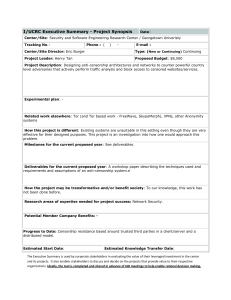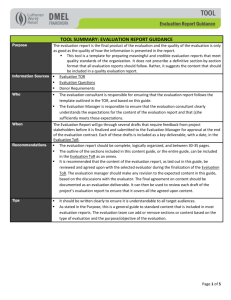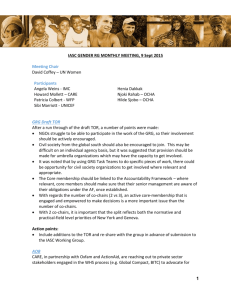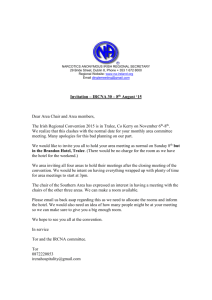SDN-MPLS 2014
advertisement
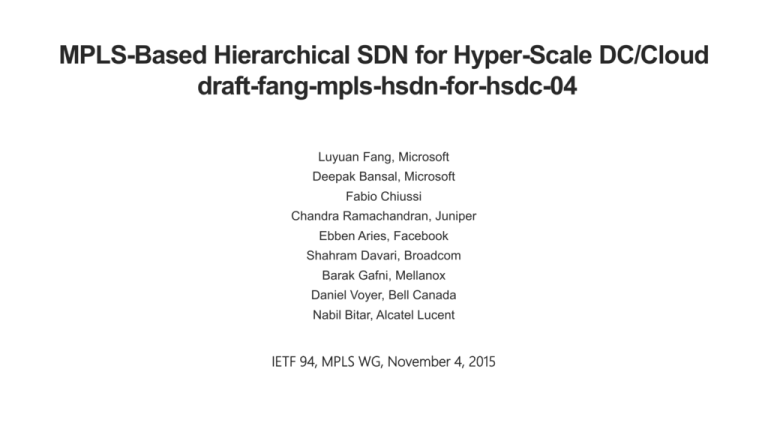
MPLS-Based Hierarchical SDN for Hyper-Scale DC/Cloud draft-fang-mpls-hsdn-for-hsdc-04 Luyuan Fang, Microsoft Deepak Bansal, Microsoft Fabio Chiussi Chandra Ramachandran, Juniper Ebben Aries, Facebook Shahram Davari, Broadcom Barak Gafni, Mellanox Daniel Voyer, Bell Canada Nabil Bitar, Alcatel Lucent IETF 94, MPLS WG, November 4, 2015 Status • HSDN architecture has been widely supported from both industry and academia • It created the foundation architecture for scalability to tens of millions endpoints, which was not previously achievable • It is being adopted and applied to different forwarding technologies (L3, L2, L1, IPv4, IPv6, MPLS, SR) • The key concept of partition and hierarchy is being applied to the control plane Reference: “Hierarchical SDN for the Hyper-Scale, Hyper-Elastic Data Center and Cloud,” Proc. ACM SIGCOMM Symposium on SDN Research, June 2015, http://dl.acm.org/citation.cfm?id=2775009 • Contains the LFIB computation details with ECMP and TE, scalability analysis, and performance data Benefit of Hierarchical SDN (HSDN) • Partitioning is crucial for scaling to 10’s of millions endpoints • HSDN is the architecture for partitioning the DC and DCI • The principle applies to any forwarding: MPLS, SR, IPv4, and IPv6, L2 or even L1 • The control plane can be implemented with full SDN approach or using BGP-LU for label distribution (draft-fang-idr-bgplu-for-hsdn-01) • Two game-changing properties of HSDN • All paths in the network can be pre-established in the LFIBs (with small LFIBs) • Labels can identify paths, not just destinations All Paths are set: support End-to-End Any-to-Any TE and ECMP concurrently HSDN: Hierarchical Underlay Partitioning UP0 Level 0 PL0 UPBN1 DC 1 GW Level 1 SN PL1 Level 2 PL2 Overlay Level VL UPBN2 1,1 UPBG2 UPBN2 1,1 1,1 UPBN2 1,2 UP2,1,1 UPBN1 DC 1 GW UPBG1,1 UP1,1 SN UPBG2 UPBN2 1,2 1,2 DCI/WAN UPBN1 N SN UPBN2 1,3 UP2,1,2 UP1,N SN UPBG2 UPBN2 1,3 1,3 UP2,1,M-1 UPBN2 1,M UPBG2 UPBN2 1,M 1,M UP2,1,M ToR ToR ToR ToR ToR ToR ToR ToR ToR ToR ToR ToR VM VM VM VM VM VM VM VM VM VM VM VM VM VM VM VM VM VM VM VM VM VM VM VM • One path label per level of underlay partition, plus one VN label • Labels are “static,” globally unique within each partition UPBG2 N,1 UP2 N,1 Example: • UPBG1, UPBN1 N N UP0 = DCI; UP1s = DCs; UP2s = Clusters With 3 levels, easily scale to 10’s of millions of endpoints UPBG2 N,M UP2 N,M HSDN Forwarding: The Life of a Packet UP0 HSDN Label Stack PL0 PL1 PL2 VL 4 28 37 14 IP Payload UPBN1 DC 4 GW PL0 Identifies dest. UPBN1 or UPBG1 28 37 14 IP Payload UPBN1 4 UPBG1,4 UPBN1 DC N GW UP1,4 UPBN1 N UPBG1,N UP1,N 37 14 IP Payload PL1 Identifies dest. UPBN2 or UPBG2 within UP1 PL2 Identifies dest. server within UP2 VL UPBN2 4,28 UPBG2 UPBN2 4,28 4,28 UPBN2 4,M UP2,4,28 ToR ToR UPBG2 UPBN2 4,M 4,M UPBN2 N,1 UP2,4,M ToR UPBG2 UPBN2 N,1 N,1 UP2,N,1 ToR ToR UPBN2 N,M UP2,N,M ToR ToR 14 IP Payload VN 14 IP Payload VM VM VM VM VM VM VM VM UPBG2 UPBN2 N,M N,M VM VM VM VM ToR 4 IP Payload 28 37 14 IP Payload Push VL, Push PL2, Push PL1, Push PL0 Identifies VN • Route optimization • Forward a packet from any source to any destination using the same (or less) number of hops as in a flat architecture and without introducing any additional latency • “Turn Around” entry to optimize label usage Next Steps • Issue -05 draft adding new co-authors and contributors • Request for WG adoption

